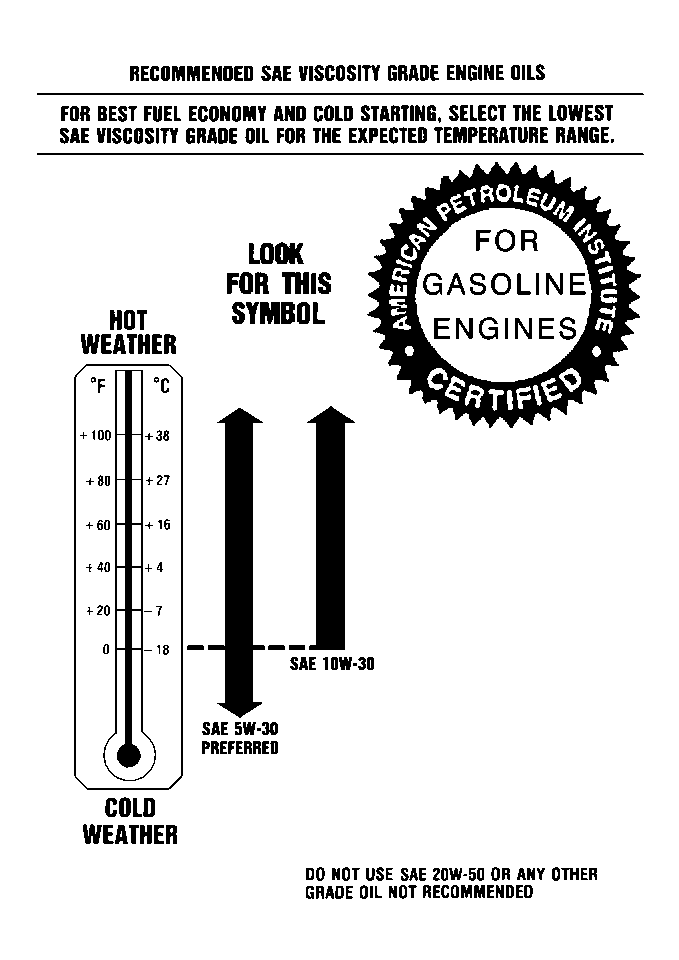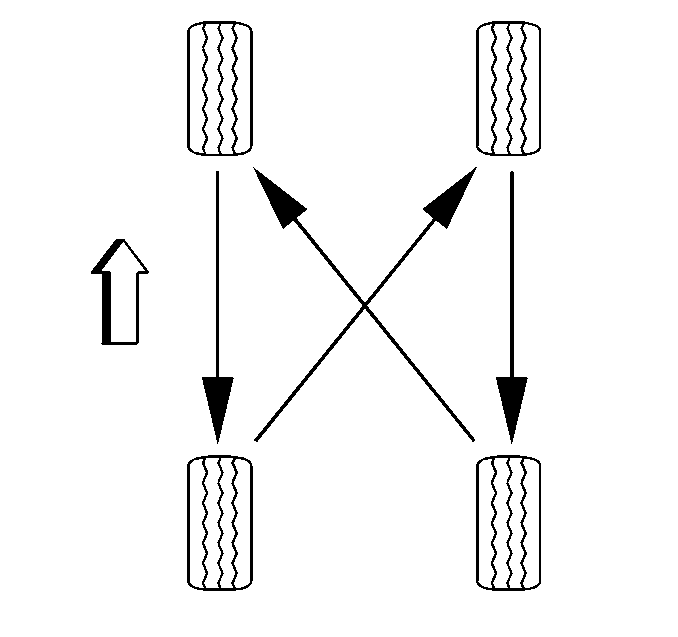Draining and Refilling Engine Oil
Important: When changing the oil on vehicles equipped with L61 engine, remove the oil fill cap and/or the oil filter cap prior to removing the oil pan drain plug.
Keeping the caps in place may create a vacuum effect that can slow the draining process. Allow sufficient time for thorough draining of the engine oil.
Engine Oil and Oil Filter Change
Replace the engine oil and the engine oil filter.
Engine Oil Quality

Oils of the proper quality for the vehicle can be identified by looking for the Starburst symbol. The Starburst symbol indicates that the oil has been certified by the American Petroleum Institute (API), and is preferred for use in gasoline engines.
Engine Oil Viscosity
SAE 5W-30 is the only viscosity grade recommended for your vehicle.
Notice: Using oils of any viscosity other than those recommended could result in engine damage. When choosing an oil, consider the range of temperatures the vehicle will be operated in before the next oil change. Then, select the recommended oil viscosity.
Use only oils which have the API Starburst symbol and which are also identified as SAE 5W-30.
If the temperature range is 0°F (-18°C) or above SAE 10W-30 oil which has the API Starbust symbol is acceptable if SAE 5W 30 oils is not available. Areas where the temperature falls below -20°F (-29°C), it is recommended either an SAE 5W-30 synthetic oil or and SAE 0W-30 oil. Both will provide easier cold starting and better protection for the engine at extremely low temperatures. Do not use other viscosity grade oils, such as SAE 10W-40 or SAE 20W-50 under any conditions.
Engine Oil Filter Replacement
The 2.2L four cylinder (L61) engine oil filter is located in the front left side of the engine and must be accessed from the top of the vehicle.
The 3.0L V6 (L81) engine oil filter is located on the front of the engine and must be accessed form underneath the vehicle.
Both engines use different paper cartridge-style oil filter elements rather than a spin-on canister-type oil filter. The oil filter elements for the two engines look similar but can not be interchanged. Ensure to use the proper oil filter. Refer to Maintenance Items .
Tire and Wheel Inspection and Rotation
Caution: Rust or dirt on a wheel, or on the parts to which it is fastened, can make wheel nuts become loose after a time. The wheel could come off and cause an accident. When you change a wheel, remove any rust or dirt from places where the wheel attaches to the vehicle. In an emergency, you can use a cloth or a paper towel to do this; but be sure to use a scraper or wire brush later, if you need to, to get all the rust or dirt off.

Tires should be rotated at 10 000 km (6,000 mi) and then every 20 000 km (12,000 mi) thereafter.
Check the tires for abnormal wear or damage. If irregular or premature tire wear exists, refer to Tire Diagnosis - Irregular or Premature Wear in Tires and Wheels.
Rotate the tires to equalize the wear and obtain maximum tire life. Refer to Tire Rotation in Tires and Wheels.
When rotating tires, always use the correct rotation pattern. Do not include the compact spare tire in your tire rotation.
If towing Saturn vehicle with all four wheels on the ground, the transmission and tire maintenance should be scheduled by mileage accumulated through both driving and towing, not to driven odometer mileage. Tire wear will reflect actual rolling mileage and may be greater than expected for the current odometer mileage.
After the tires have been rotated, adjust the front and rear inflation pressures as shown on the Tire Placard .
Ensure all wheel nuts are properly tightened. Refer to Approximate Fluid Capacities .
Brake System Inspection
Inspect brake lines and hoses for proper hook-up binding, leaks, cracks or chafing. Inspect disc brake pads for wear. Refer to Brake Pad Inspection in Disc Brakes. Inspect the rotors for poor surface condition. Inspect other brake system components, including brake calipers and the parking brake. Check the parking brake adjustment. The brakes may need to be inspected more often if the customer's driving habits or conditions result in frequent braking.
Air Cleaner Filter Inspection and Replacement
Inspect the air cleaner filter every 25 000 km (15,000 mi) if driving in dusty conditions. Replace if necessary. Replace the air cleaner filter every 50 000 km (30,000 mi). Replace more often under dusty conditions. Refer to Air Cleaner Element Replacement in Engine Controls.
Automatic Transaxle Service
It is not necessary to check the transmission fluid level. A transmission fluid leak is the only reason for fluid loss. If a leak occurs, take the vehicle to your Saturn retailer's service department and have it repaired as soon as possible. Have fluid level check by retailer or service center when oil is changed. Refer to Maintenance Schedule .
Manual Transmission Fluid
Notice: We recommend you use only fluid labeled DEXRON® -III, because fluid with that label is made especially for your automatic transmission. Damage caused by fluid other than DEXRON® -III is not covered by your new vehicle warranty.
It is not necessary to check the manual transmission fluid level. A transmission leak is the only reason for fluid loss. If a leak occurs, take the vehicle to the Saturn retailer's service department and have repaired as soon as possible. Have fluid level checked by retailer or service center when oil is changed. The manual transmission fluid does not require changing.
Drive Belt Inspection
Inspect the engine accessory drive belt and coolant hoses every 12 months or 18,000 miles (30 000 km), whichever comes first for:
| • | Cracks |
| • | Fraying |
| • | Wear |
| • | Proper belt tension |
| Belts can have small cracks in individual ribs without affecting performance. Refer to Drive Belt Replacement in Engine Mechanical. |
Cooling System Service
Drain, flush and refill the cooling system with new coolant. Refer to Cooling System Draining and Filling in Engine Cooling.
Spark Plug Wire Inspection
Clean the spark plug wires and inspect for burns, cracks or other damage. Ensure that the fit between the spark plug wire boots at the spark plugs and at the coils is snug. Replace the spark plug wires as needed. Refer to Spark Plug Inspection in Engine Controls.
Spark Plug Replacement
Replace the spark plugs. Refer to Spark Plug Replacement Engine Controls.
